William Cudworth, Member,
Institution of Civil Engineers |
||
|
||
| Obituary in Minutes of Proceedings, Inst. C.E., vol. 166,
1905-6, pp 381-2 WILLIAM CUDWORTH was born at Darlington in 1815 and was educated privately. As a boy, he witnessed the opening, in September, 1825, of the Stockton and Darlington Railway, with the fortunes of which his future became largely identified. He was apprenticed to a shipbuilder in Sunderland, and obtained in the shipyard a thorough knowledge of carpentry and of wooden shipbuilding, which was supplemented by a short voyage as a sailor. Thus equipped, he commenced business as a shipbuilder in the then recently founded town of Middlesbrough, but gave this up in 1840 and entered the service of the Stockton and Darlington Railway Company under the late Mr. John Harris. About 1850, when the Cleveland iron-mining district was being developed, he was appointed engineer for the construction of the Middlesbrough and Guisborough Railway, a feeder to the Stockton and Darlington line; and on the completion of this work he found full occupation in connection with a series of protracted parliamentary contests which arose out of the proposed further development of that district. In 1857 and the following year, the construction of the Hownes Gill Viaduct on the Stockton and Darlington Railway occupied much of his attention, and about this time he succeeded Mr. John Dixon as engineer to that railway, retaining this position in the Darlington District after the amalgamation of the Stockton and Darlington with the North Eastern Railway. As Engineer to the Company, he carried out large groups of marshalling sidings at Shildon and Newport, new passenger- and goods-stations on an extended scale, widenings, and other works necessitated by the exceptionally rapid development of the Middlesbrough District. About 1869 he took in hand the enlargement of Middlesbrough Dock, the late Mr. T. E. Harrison being Consulting Engineer. This was new work to Mr. Cudworth, but his love for ships and shipping made it congenial. In 1883, shortly after the death of his wife, he retired from professional life, and devoted the prolonged remainder of his days to works of philanthropy and to literature. Possessing a cultivated literary taste, he occupied himself in making translations into English verse of several of the masterpieces of Greek and Latin literature. When over 80 years of age he learned Italian in order to read Dante in the original. He died on the 4th of June, 1906, in his ninety-first year. Mr. Cudworth was ever calm in demeanour and careful and exact in his use of language; and he was eminently just and upright in all the affairs of life. He was elected a Member of the Institution on the 1st May, 1860.
|
Obituary in The Engineer, June 8, 1906, p.579 WILLIAM CUDWORTH We announce with regret the death on Monday, at Saltburn, of Mr. William Cudworth, late one of the chief engineers of the North-Eastern Railway Company in his ninety-first year. He was a native of Darlington, and as a youth became associated with the old Stockton and Darlington Railway, the first passenger railway in the world. Under Mr. John Dixon, the first permanent way engineer, the late Mr. Cudworth served his apprenticeship, and subsequently he succeeded that gentleman in his position of chief engineer of the Stockton and Darlington Railway. After the amalgamation of that railway with the North-Eastern Railway in 1873, Mr. Cudworth continued in the post of chief permanent way engineer until his retirement from professional life. His son, Mr. W. J. Cudworth, late of Darlington and now of York, is chief engineer of the southern division of the North-Eastern Railway at the present time, and his brother James, who was once locomotive superintendent at Bank Top, Darlington, has been well known in connection with the locomotive department of the South-Eastern Railway. Mr. Cudworth's sister married the late Alderman Kitching, one of the leading builders of locomotives in the country; he constructed the Derwent, which now stands on a pedestal in Bank Top Station, Darlington. Alderman Kitching was a director of the North-Eastern Railway.
|
|

 Aerial photo of Hownes Gill Viaduct, still standing but the only traffic over
it is by hikers and cyclists on the
Aerial photo of Hownes Gill Viaduct, still standing but the only traffic over
it is by hikers and cyclists on the